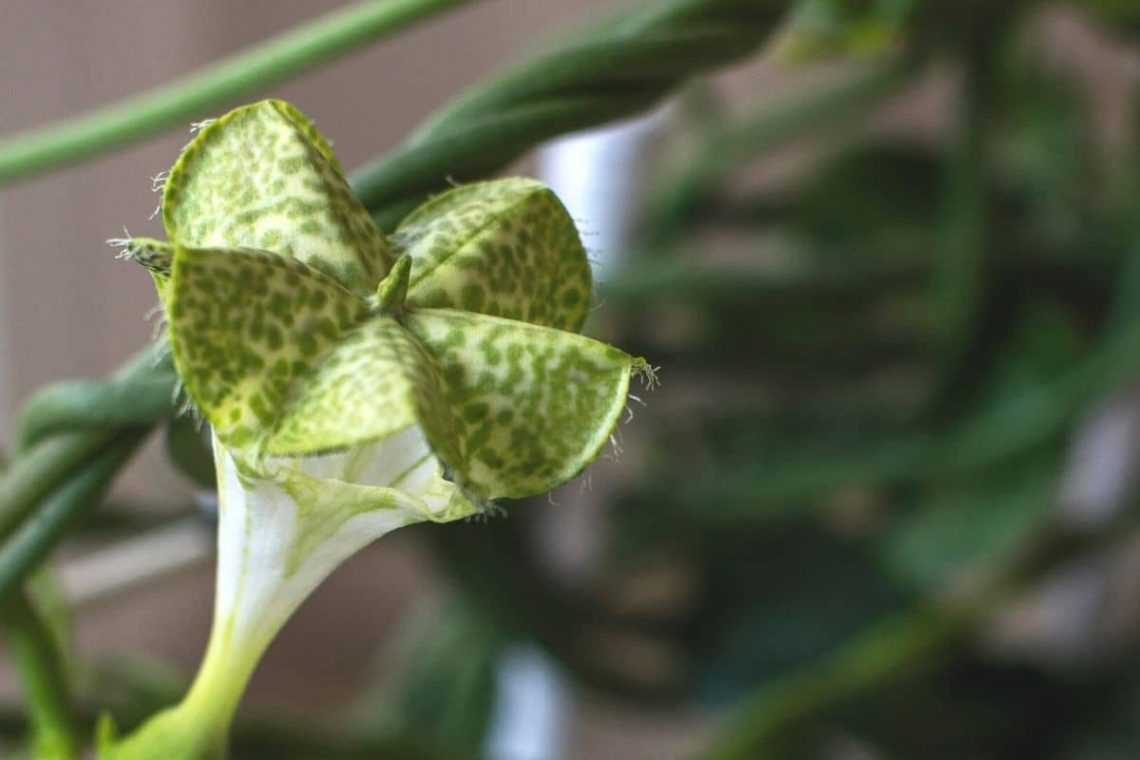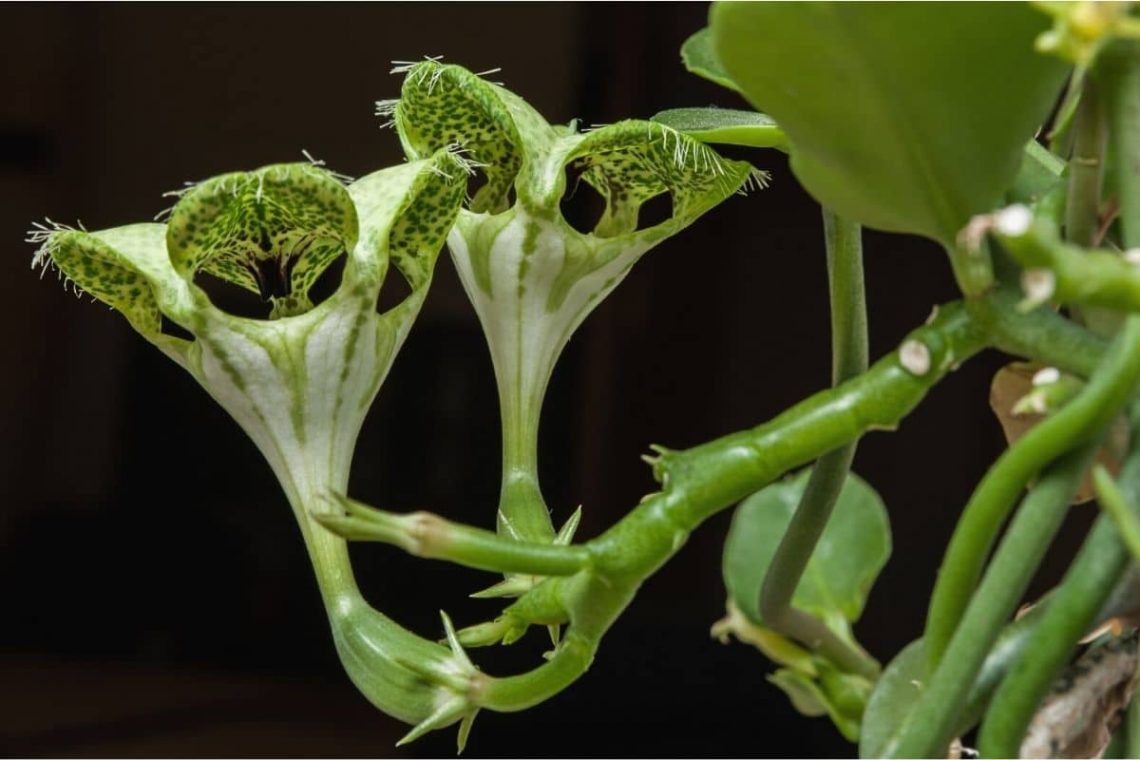Last updated on October 23rd, 2023 at 08:53 pm
In this country, climbing candlestick flower (Ceropegia sandersonii) is particularly popular as a houseplant. It can be equipped with a climbing aid or cultivated hanging in a hanging basket. If the appropriate location and the ideal substrate are chosen, the plant requires little further care.
Contents
- 1 Soil condition and location
- 2 Watering and fertilizing
- 3 Diseases and pests
- 4 Plants
- 5 Pruning
- 6 Wintering
- 7 Propagation
- 8 Through leaf tubers
- 9 By cuttings
- 10 Select cuttings
- 11 Is the climbing candlestick flower dangerous for children and pets?
- 12 Can I propagate the climbing candelabra flower by seed?
- 13 Does my Climbing Chandelier Flower require high humidity?
- 14 Author
Soil condition and location
The location in the house should be bright and have a normal living temperature. However, direct sunlight, especially from the midday sun, is not well tolerated by the plant and should therefore be avoided. In summer, the Climbing Candlestick Flower may also move to a sheltered place outside:
- near east or west window
- in the sunlight on the plant blinds or curtains move
- in summer protected on balcony or terrace
- east or west side of the house
- bright corner is ideal
- succulent feels particularly well in cactus soil
- contains all the necessary nutrients
- Soil permeable and humus
- also suitable for potted plants
- enrich with sand and balls of expanded clay
- Flowering and flowering time
The candlestick flowers owe their name to the appearance of their decorative flowers. The main flowering period here falls in late summer to autumn:
- tubular flowers up to 7 centimeters in size
- slightly bulbous at the base
- sit directly on leaf axils
- at the tip five thin tips
- grown to a kind of umbrella
- thus resemble small lamp chandeliers

Note: The small heart-shaped leaves with a white-silvery grain also provide decorative ornamental value, especially during the period when the plant has not formed flowers.
Watering and fertilizing
Succulents store water very well and therefore require only a few waterings, even in summer. This is because the Climbing Candelabrum stores water in both the fleshy, thick leaves and the root tubers:
- Water moderately on a regular basis during the growing season
- from April to September
- less in winter
- but never let the root ball dry out completely
- use low-calcium water, e.g. rainwater
- Fertilization is also done during the growth phase
- once a month with cactus fertilizer from the trade
- Use liquid fertilizer in small doses
- mix with water
Diseases and pests
Even though Ceropegia sandersonii is a very robust plant, there are occasional pest infestations. In addition, with poor care and due to too much watering or lack of drainage on the bottom of the pot, root rot can occur:
Plant loses color and becomes limp
Remove immediately from the pot
Use fresh substrate and water little
Infestation with the red spider mite (Panonychus ulmi), a species of spider mite, is also possible:
- Leaves covered with fine webs
- show small light spots
- later leaves become copper-brown
- Wash off the plant altogether and thus reduce pests
- Use commercial insecticides
- Riveting products for the irrigation water are ideal here
- Note: Infestations of aphids or mealybugs may also occur, which can also be treated with the same insecticides.
Plants
Climbing candlestick flower is commercially available as a ready-made plant and is usually supplied in a container. However, this is not suitable for further cultivation, as the plants often do not have enough space in the pots, in addition, the soil is usually not of high enough quality for prolonged cultivation:
- Against waterlogging create drainage via drainage hole.
- choose gravel or clay balls
- plant fleece over this
- fill in almost the entire prepared soil
- Root tuber should sit only very lightly in the soil
- Remove the plant from the old pot
- remove soil from roots
- briefly immerse in a container with water
- insert the plant and fill in the remaining soil around it
- water well
Tip: To ensure that the plant also climbs upwards, you should insert a climbing aid directly into the soil when planting. Alternatively, you can also plant the climbing candelabra flower hanging in a hanging pot and hang it up or place it on a cabinet or shelf and let the shoots hang down.
Pruning
Pruning Ceropegia sandersonii is not necessary for its care. Nevertheless, too long shoots can be cut back for visual reasons. However, this pruning should always be done in spring only. Normal household scissors are sufficient, provided they are sharp, cleaned and disinfected, so that no injuries occur on the plant or germs enter via the cut. The cut shoots can then be used as cuttings for propagation.
Wintering
Even though Ceropegia sandersonii is an indoor plant, it should still be given appropriate overwintering. Because the warm heated air in a living room does not tolerate the candlestick flower so well:
- cool and bright place
- unheated winter garden
- alternatively bright staircase
- little watering
- do not fertilize
- repotting
Ceropegia sandersonii requires little care, which also applies to repotting. Because this is not necessary every year with this plant. The best time for repotting is spring in March. To do this, simply choose a slightly larger pot than the previous one and proceed in the same way as in the section “Planting”.

Propagation
There are several options to choose from for propagating Climbing Candelabra flower.
Through leaf tubers
Propagation of succulents is very simple. This does not succeed by dividing the roots as with many other plants but the Climbing Candelabra flower does not even have to be removed from the pot for propagation:
- use so-called breeding nodules
- form during the growth phase
- between spring and autumn
- are located in leaf axils
- pick off the nodules
- simply sprinkle on soil
- use a bowl with cactus soil
- cover with quartz sand
- choose a shady location
- place in a cool place between 16° and 18° Celsius
When the first shoots and leaves appear, the small plants can be planted in their own pot.
Note: When propagating, you must ensure constant soil moisture. The layer of quartz sand on the nodules should prevent rot from forming here, as the pots tend to be cool and dark.
By cuttings
Propagation by cuttings is also possible and succeeds quite easily. If the plant has neither fruits to form seeds nor breeding nodules on the leaf axils, then propagation is possible as follows:
Select cuttings
- usually in spring
- cut off about 10 to 15 centimeters from the shoot
- allow the cut ends to dry out
- put them into pots with growing soil
- always keep the soil slightly moist
- alternatively put them in a glass with water
- place both in a bright and warm place
- avoid direct sunlight
Tip: Even though the cuttings can be taken throughout the entire growing season, the beginning of the year is best for this. Because then the new plants obtained in this way can still use the entire growing season itself.
Frequently asked questions
Is the climbing candlestick flower dangerous for children and pets?
Although Ceropegia sandersonii belongs to the dog poison family (Apocynaceae), the plant is still completely harmless and non-toxic. Even the exuding milky sap is actually non-toxic. However, it can irritate the skin of sensitive people, so it is recommended to wear gloves when caring for the plant.
Can I propagate the climbing candelabra flower by seed?
Of course, it is also possible to sow seeds. For this, however, the plant must have formed fruits from the flowers, which is often not the case in indoor culture. Otherwise, you can take the seeds and easily put them in growing soil. This must be kept evenly moist. Here help indoor greenhouse or alternatively a transparent film. If the first seedlings appear, you can carefully transplant them into a suitably prepared pot and place it in a bright and warm place.
Does my Climbing Chandelier Flower require high humidity?
No, this is not the case. Both dry and rather humid air are equally well tolerated. It is true that the plant should be placed in a cooler location during the winter if possible. However, since the plant can also cope with dry air, it can also remain in the same place all year round and will then cope quite well with the warmer heating air.


